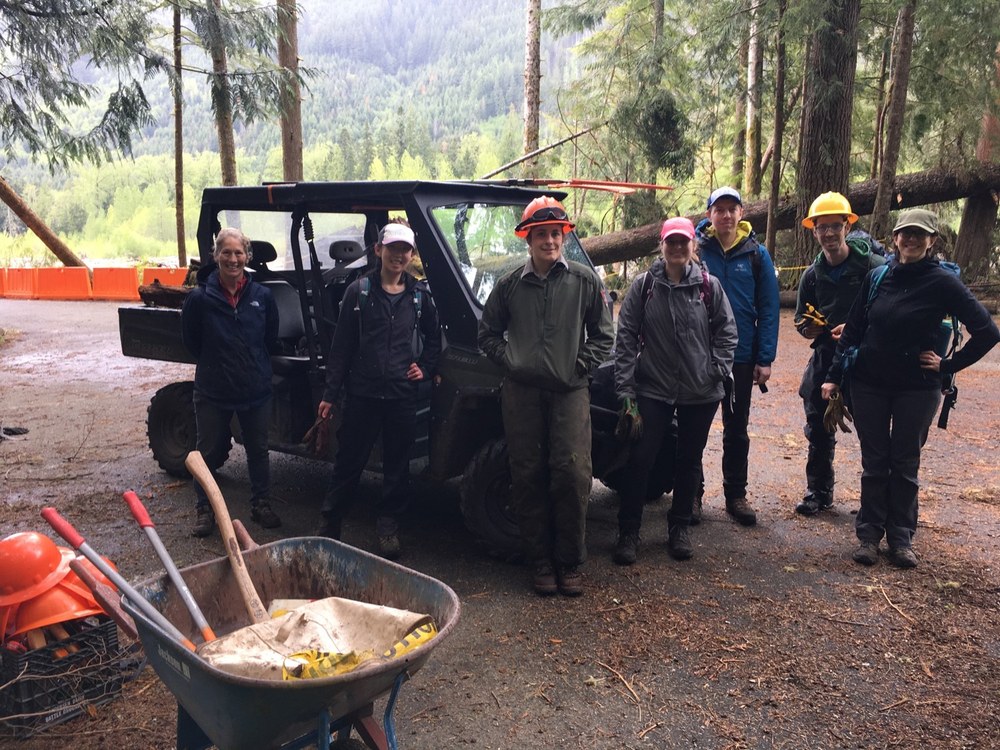
Mountaineers have cherished the natural beauty and challenges offered by Mount Rainier since our beginning, and stewardship and volunteering have always been a part of that story. Early members helped build the original Wonderland Trail, and many current and former members volunteer their time to care for this special place today.
The park received nearly 2.5 million visitors in 2021 alone. Increasing visitation and its impacts underscore the need for continued stewardship of the park’s meadows, forests, and trails. The following is adapted from a recent conversation with Tacoma branch member and Mount Rainier National Park volunteer Margot Tsakonas.
Could you share a personal experience that sparked your connection to the park?
My early visits revealed the wonder of Mount Rainier and really taught me to appreciate the landscape and the opportunities for connection it provides. I first got involved as a volunteer with one of the park’s popular programs, Meadow Rovers. It’s all about achieving a safe and enjoyable visitor experience, which really appealed to me.
Through Meadow Rovers, volunteers support staff in the Paradise area by helping educate visitors about safety, appropriate behavior, and what to be aware of during their visit in a way that enhances their overall experience. A few years as a Rover led to other volunteer opportunities and many memorable experiences and connections.
What role do you think Mount Rainier plays in The Mountaineers story and experience - both past and present?
The Mountaineers relationship with Mount Rainier goes back over a hundred years, but it’s important to acknowledge that Native peoples were the original stewards of this landscape. Their connection to the area continues today.
The Mountaineers were early advocates for the park. Even before it became a national park in 1899, engaged mountaineering conservationists advocated for protecting that landscape. Mount Rainier National Park continues to be intertwined with The Mountaineers experience. Regardless of where you live, I think most Mountaineers have a special place in their heart for Mount Rainier.
Why do you feel it's important for Mountaineers to care for the park and protect the special outdoor experiences it provides?
I think the old idea that we can go out and enjoy our wilderness experiences, and that it will continue to be there for us, is changing. These areas are not going to be around forever if we don't really take care of them. I think outdoor recreationalists of all sorts - anglers, kayakers, hikers, climbers, and others - have a responsibility to engage in maintaining, preserving, and stewarding our wild public lands.
Mountaineers visit Mount Rainier frequently, so I think that's a really good opportunity for us to practice what we preach in a way that works for each of us. You don’t have to always go out on-trail with a shovel. You might just want to support Washington’s three national parks by purchasing a national parks license plate for your vehicle. You can volunteer, donate, get involved in educational efforts, and advocate for the park.
Could you share a little more about the different volunteer roles you’ve held in the park and what impact you think you’ve had through those efforts?
I currently serve as a Volunteers In Parks Wilderness Ranger and continue to volunteer as a Meadow Rover. I’ve also worked on a special project surveying for invasive plants on the park’s eastside trails, participated in MeadoWatch - a citizen science project about climate change - and I currently participate in wildlife surveys in conjunction with Cascade Carnivore Project.
My winter volunteering has included assisting with ranger-led snowshoe hikes in the Paradise area. Many participants on these walks are new to winter recreation. Those programs allow you to meet visitors from all over, but also witness local residents connect with - and learn about - their surroundings in new ways.
It’s hard to gauge my individual impact from these various opportunities, but I like to think I’ve had many small impacts from my interactions with visitors by helping them enjoy themselves and ensuring that they have the necessary knowledge to do their part to protect the park’s natural resources.
How can Mountaineers and other recreationists help steward and support Mount Rainier National Park?
There are many opportunities for Mountaineers to steward the park, both in groups and as individuals. Equipping yourself with some basic knowledge about the park, how it’s mostly wilderness, and other access and use restrictions is a good place to start.
Mount Rainier’s Volunteers In Parks program (VIP) connects hundreds of volunteers each year to meaningful opportunities, resulting in thousands of hours of support annually. There are quite a few current and former Mountaineers members volunteering in many roles, including camp host, archives, staffing the wilderness information centers, and even working with the volunteer nordic patrol.
Check out Mount Rainier National Park’s volunteer program page for more information about the various ways you can volunteer.
I also encourage any members interested in tracking the management of the park to visit the park’s planning page. It’s a good place for information on which park projects are being evaluated and how you can make your voice heard on issues affecting the park and the visitor experience.
Stewardship is a year-round focus for our community, and the warmer months can be a great time to venture outside and give back to our region’s public lands through trail maintenance, clearing invasive plants, planting native species, and more. Learn more about The Mountaineers Stewardship Credit badge - a requirement for many of our courses - and find upcoming activities to get involved in a stewardship project near you.
 Conor Marshall
Conor Marshall